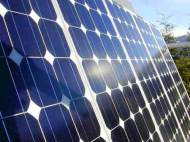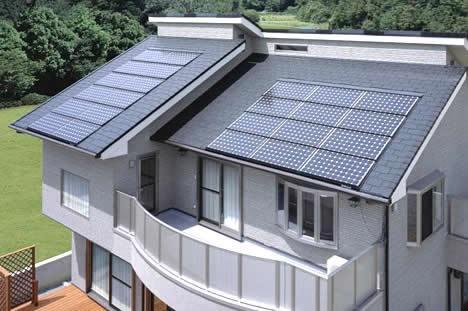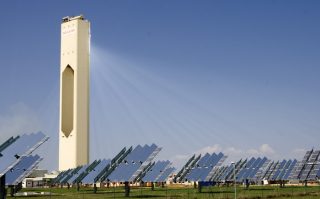Using solar energy – Solar power
 This is a rather general overview of contemporary technologies which convert solar energy into electrical power. As we run out of conventional fuels solar energy becomes one of the main subjects regarding our power supply thus supply of our gadgets and robots. Hence, solar power is going to be one of the subjects we’re going to cover regularly.
This is a rather general overview of contemporary technologies which convert solar energy into electrical power. As we run out of conventional fuels solar energy becomes one of the main subjects regarding our power supply thus supply of our gadgets and robots. Hence, solar power is going to be one of the subjects we’re going to cover regularly.
The Earth receives 174 petawatts (PW) of incoming solar radiation (insolation) at the upper atmosphere of which approximately 30% is being reflected back to space while the rest is being absorbed by clouds, oceans and land masses. The spectrum of solar light at the Earth’s surface is mostly spread across the visible and near-infrared ranges with a small part in the near-ultraviolet.
Solar energy refers primarily to the use of solar radiation for practical ends. All other renewable energies other than geothermal derive their energy from the sun.
Solar technologies are broadly characterized as either passive or active depending on the way they capture, convert and distribute sunlight. Active solar techniques use photovoltaic panels, pumps, and fans to convert sunlight into useful outputs. Passive solar techniques include selecting materials with favorable thermal properties, designing spaces that naturally circulate air, and referencing the position of a building to the Sun. Active solar technologies increase the supply of energy and are considered supply side technologies, while passive solar technologies reduce the need for alternate resources and are generally considered demand side technologies.
Sunlight can be converted into electricity using photovoltaic (PV), concentrating solar power (CSP), and various experimental technologies. PV has mainly been used to power small and medium-sized applications, from the calculator powered by a single solar cell to off-grid homes powered by a photovoltaic array.
Photovoltaic is best known as a method for generating electric power by using solar cells packaged in photovoltaic modules, often electrically connected in multiples as solar photovoltaic arrays to convert energy from the sun into electricity by directing photons from sunlight to knock electrons into a higher state of energy, thereby creating electricity. Almost all photovoltaic devices are some type of photodiode.
The first practical application of photovoltaic was to power orbiting satellites and other spacecraft, but today the majority of photovoltaic modules are used for grid connected power generation. In this case an inverter is required to convert the DC to AC. There is a smaller market for off grid power for remote dwellings, roadside emergency telephones, remote sensing, and cathodic protection of pipelines.
Cells require protection from the environment and are usually packaged tightly behind a glass sheet. When more power is required than a single cell can deliver, cells are electrically connected together to form photovoltaic modules, or solar panels. A single module is enough to power an emergency telephone, but for a house or a power plant the modules must be arranged in arrays. Although the selling price of modules is still too high to compete with grid electricity in most places, significant financial incentives in Japan and then Germany and Italy triggered a huge growth in demand, followed quickly by production.
Perhaps not unexpectedly, a significant market has emerged in off-grid locations for solar-power-charged storage-battery based solutions. These often provide the only electricity available.
Some of the applications of PV are in power stations, buildings, transport, in standalone devices, in areas of rural electrification and on solar roadways.
Concentrating solar power (CSP) systems use lenses or mirrors and tracking systems to focus a large area of sunlight into a small beam. The concentrated light is then used as a heat source for a conventional power plant or is concentrated onto photovoltaic surfaces.
Concentrating solar thermal (CST) is used to produce renewable heat or electricity (generally, in the latter case, through steam). CST systems use lenses or mirrors and tracking systems to focus a large area of sunlight into a small beam. The concentrated light is then used as heat or as a heat source for a conventional power plant (solar thermoelectricity).
A wide range of concentrating technologies exist, including the parabolic trough, Dish Stirling, Concentrating Linear Fresnel Reflector, Solar chimney and solar power tower. Each concentration method is capable of producing high temperatures and correspondingly high thermodynamic efficiencies, but they vary in the way that they track the Sun and focus light. Due new innovations in the technology, concentrating solar thermal is being more and more cost-effective.
· A parabolic trough consists of a linear parabolic reflector that concentrates light onto a receiver positioned along the reflector’s focal line. The receiver is a tube positioned right above the middle of the parabolic mirror and is filled with a working fluid. The reflector follows the Sun during the daylight hours by tracking along a single axis. A working fluid (e.g. molten salt) is heated to 150-350 °C as it flows through the receiver and is then used as a heat source for a power generation system. Trough systems are the most developed CSP technology. The Solar Energy Generating Systems (SEGS) plants in California, Acciona’s Nevada Solar One near Boulder City, Nevada, and Plataforma Solar de Almería’s SSPS-DCS plant in Spain are representatives of this technology.
· Concentrating Linear Fresnel Reflectors are CSP-plants which use many thin mirror strips instead of parabolic mirrors to concentrate sunlight onto two tubes with working fluid. This has the advantage that flat mirrors can be used and those are much cheaper than parabolic mirrors, and that more reflectors can be placed in the same amount of space, allowing more of the available sunlight to be used. Concentrating Linear Fresnel reflector can come in large plants or more compact plants.
· A Dish Stirling or dish engine system consists of a stand-alone parabolic reflector that concentrates light onto a receiver positioned at the reflector’s focal point. The reflector tracks the Sun along two axes. The working fluid in the receiver is heated to 250-700 °C and then used by a Stirling engine to generate power. Parabolic dish systems provide the highest solar-to-electric efficiency among CSP technologies, and their modular nature provides scalability. The Stirling Energy Systems (SES) and Science Applications International Corporation (SAIC) dishes at UNLV and the Big Dish in Canberra, Australia are representatives of this technology.
· A Solar chimney consists of a transparent large room (usually completely in glass) which is sloped gently up to a central hollow tower or chimney. The sun heats the air in this greenhouse-type structure which then rises up the chimney, hereby driving an air turbine as it rises. This air turbine hereby creates electricity. Solar chimneys are very simple in design and could therefore be a viable option for projects in the developing world.
· A solar power tower consists of an array of dual-axis tracking reflectors (heliostats) that concentrate light on a central receiver atop a tower; the receiver contains a fluid deposit, which can consist of sea water. The working fluid in the receiver is heated to 500-1000 °C and then used as a heat source for a power generation or energy storage system. Power tower development is less advanced than trough systems, but they offer higher efficiency and better energy storage capability. The Solar Two in Daggett, California and the Planta Solar 10 (PS10) in Sanlucar la Mayor, Spain are representatives of this technology.
Concentrating Solar Thermal Power (CSP) is the main technology proposed for a cooperation to produce electricity and desalinated water in the arid regions of North Africa and Southern Europe by the Trans-Mediterranean Renewable Energy Cooperation DESERTEC.
Concentrating photovoltaics (CPV) systems employ sunlight concentrated onto photovoltaic surfaces for the purpose of electrical power production. Solar concentrators of all varieties may be used, and these are often mounted on a solar tracker in order to keep the focal point upon the cell as the Sun moves across the sky.
The generating ability of a solar updraft power plant depends primarily on two factors: the size of the collector area and chimney height. With a larger collector area, a greater volume of air is warmed to flow up the chimney; collector areas as large as 7 km in diameter have been considered. With a larger chimney height, the pressure difference increases the stack effect; chimneys as tall as 1000 m have been considered.
Heat can be stored inside the collector area greenhouse to be used to warm the air later on. Water, with its relatively high specific heat capacity, can be filled in tubes placed under the collector increasing the energy storage as needed.
Turbines can be installed in a ring around the base of the tower, with a horizontal axis, as planned for the Australian project and seen in the diagram above; or—as in the prototype in Spain—a single vertical axis turbine can be installed inside the chimney.
Carbon dioxide is emitted only negligibly while operating, but is emitted more significantly during manufacture of its construction materials, particularly cement. Net energy payback is estimated to be 2–3 years.
A solar updraft tower power station would consume a significant area of land if it were designed to generate as much electricity as is produced by modern power stations using conventional technology. Construction would be most likely in hot areas with large amounts of very low-value land, such as deserts, or otherwise degraded land.
A small-scale solar updraft tower may be an attractive option for remote regions in developing countries. The relatively low-tech approach could allow local resources and labor to be used for its construction and maintenance.
In mid 2008 the Namibian government approved a proposal for the construction of a 400 MW solar chimney called the ‘Greentower’. The tower is planned to be 1.5 km tall and 280 m in diameter, and the base will consist of a 37 km2 greenhouse in which cash crops can be grown.
Thermogenerators (TEG) are devices which convert heat (temperature differences) directly into electrical energy. For the most part, this term is synonymous with “thermoelectric generator” and rarely used in English. They most commonly work on the principle of the Seebeck effect, with typical efficiencies of around 5-10%. Older Seebeck-based devices used bimetallic junctions and were bulky while more recent devices use bismuth-telluride semiconductor p-n junctions and can have thicknesses in the millimeter range. These are solid state devices and unlike dynamos have no moving parts other than sometimes a fan.
Thermogenerators were later used in the US space program as an energy conversion technology for powering deep space missions such as Cassini, Galileo and Viking. Research in this area is focused on raising the efficiency of these devices from 7–8% to 15–20%.











An emerging area of importance is Concentrating Solar Power Systems. Concentrating solar power systems use concentrated solar radiation as a high temperature energy source to produce electrical power and drive chemical reactions. These clean energy technologies are appropriate for Sunbelt applications where direct solar radiation is high.
The Global Concentrated Solar Power industry Report 2010-
2011 provides the latest information on the thriving
Concentrated Solar Power (CSP) industry, including essential
cost and performance data on the four main CSP technologies:
Parabolic Trough, Power Tower, Fresnel and Dish Stirling.
The Highlights of the report:
“Currently there are 679 MW of installed CSP capacity worldwide
and more than 2000 MW under construction. The USA is the
market leader in terms of installed capacity with 63% market
share, followed by Spain with 32% of operating capacity. These
two markets will continue to be crucial for the development of
the industry into the next decade, with Spain accounting for the
largest share of projects under construction with almost 89%. In
terms of the technology employed, the market is dominated by
Parabolic Trough technology, which accounts for 88% of operating
plants and 97.5% of projects under construction.
The solar field represents the largest share of the cost of any CSP
plant. Depending on the technology this cost could vary from
around 43% for Tower and Fresnel technology, to almost 60% for
Parabolic Trough and Dish Stirling CSP plants. The most significant
cost reductions are likely to come about by innovations in solar field
design, which could bring down the levelized cost of energy (LCOE) by
15 to 28% depending on the technology.
Experience in Spain has shown that the electricity demand curve
almost matches the electricity production curve of a CSP plant.
Seasonal variations in solar resources have an effect on the
number of hours a CSP plant operates, reducing operating time by
almost two hours in winter. This problem can be mitigated by using
thermal storage technologies, which would allow CSP to generate
electricity during cloudy periods and through the night.”
Dr.A.Jagadeesh Nellore(AP),India